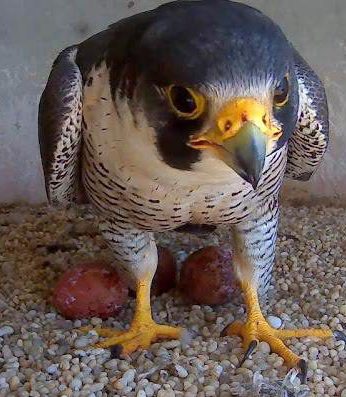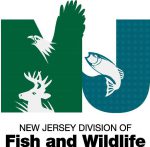Falcon Camera Update – November 17th
The work on the new cameras and microphones continues and will be completed soon. Thank You For Your Patience!
The video below gives you a behind the scenes look and a whole new perspective from on top of the County Courthouse roof.
 Welcome to the Union County Falcon Cam, providing a live stream of the action in and around the peregrine falcon nest located on the roof of the County Courthouse in midtown Elizabeth.
Welcome to the Union County Falcon Cam, providing a live stream of the action in and around the peregrine falcon nest located on the roof of the County Courthouse in midtown Elizabeth.
“The Falcon Cam is a wonderful opportunity to observe and study one of nature’s most fierce and fascinating creatures,” said Union County Commissioner Chair Rebecca Williams. “It provides an enriching experience for County residents of all ages, and for online visitors from all over the world.”
“Peregrine falcons are listed as an endangered species in New Jersey, and Union County has been part of ongoing efforts to ensure the survival of these remarkable birds statewide,” she explained. “The live feed will help build an appreciation for the role that we can all play in preserving our natural heritage, both in our parks and in the urban environment.”
Peregrine falcons are the fastest creatures on Earth. They are known for their rapid dives, which can approach an astounding 200 miles an hour as they move in on their prey.
[ezcol_2fifth]Preservation Effort
Union County’s falcon preservation efforts have been undertaken with the generous assistance of wildlife experts from New Jersey DEP and the nonprofit Conserve Wildlife Foundation of New Jersey.
The Conserve Wildlife Foundation is Union County’s official partner for educational programming related to falcons and the Falcon Cam. For more details about the educational initiative and information on corporate sponsorships, call the Conserve Wildlife Foundation at 609-984-6012 or use the contact form,
[/ezcol_2fifth] [ezcol_1fifth]
[/ezcol_1fifth_end]
Union County Peregrine Falcon Timeline
2005
- Two falcons, a male and a female, try to establish a nest on the 14th floor ledge of the 17-story County Courthouse in midtown Elizabeth.
- Leg bands reveals that the female was born in Jersey City and the male was born in Connecticut.
- The choice of location in the center of a bustling mid-sized city may seem odd, but they are likely attracted by the height of the ledge and the ample supply of prey nearby.
- Unfortunately, windy conditions are an obstacle and the attempt is unsuccessful.
2006
- Acting on the guidance of wildlife experts with the New Jersey Department of Environmental Protection, County and State workers install a repurposed igloo-style dog house on the west side of the Courthouse roof to protects eggs and chicks from the elements.
- Falcons have successfully raised chicks in the same nest every year from 2006 to 2016.
- Sometime during this period an unbanded male replaced the banded male from Connecticut.
2016
- February 2016: Two webcams are installed at the nest by Union County with guidance from the New Jersey Division of Fish & Wildlife and Conserve Wildlife Foundation. One is located inside the nest box and the other is fixed on an outside railing to capture nesting, hatching and fledgling behaviors. The outer camera can be moved by remote control, and the inner camera includes an infrared feature for night viewing.
- At some point during 2016 the Jersey City female is replaced by a banded six- year-old female. She was born at Throg’s Neck Bridge in New York City.
- Spring 2016: The pair raise three hatchlings from four eggs.
- Summer 2016: A banded chick from Union County’s 2016 clutch is found dead in Key West, Florida. The probable cause of death is electrocution due to contact with power lines, a common source of bird mortality.
- September 2016: Union County signs a Memorandum of Understanding with Conserve Wildlife Foundation for the purpose of “educating the public about peregrine falcons, their habitats and the importance of protecting rare species of wildlife.
- Fall 2016: A third camera is installed on the Courthouse roof to track activity on the east side of the courthouse roof.
- December 25, 2016: The Throg’s Neck female is seen on camera for the last time.
- December 28, 2016: An unbanded female replaces the Throg’s Neck female.
2017
- February 2017: The male falcon and the unbanded female continue to bond at the nest site. Video 1 | Video 2
- Late February: A second female is spotted on the falcon cam. This female has a leg band identifying her as 91/BA, who came to Union County all the way from Rochester, New York. Drama ensues as she attempts to claim the nest site. This distraction could possibly cause a delay in mating and breeding. Video
- March 22: The unbanded female lays her first egg.
- March 25: The unbanded female lays her second egg
- March-April: After a protracted battle 91/BA establishes claim over the nest.
- Earth Day -- April 22: At approximately 1:59 p.m. 91/BA lays an egg of her own, making a total of three in the nest.
- April 24 and April 27: 91/BA lays two more eggs, for a total of five. The male and 91/BA are sharing incubation duties for all five eggs together.
- May 8: All five eggs are still being incubated together but the two older eggs were expected to hatch over the weekend. They are now considered nonviable, most likely due to inconsistent incubation during the territorial battle between the unbanded female and 91/BA.
- May 30 and 31: The first (video) and second eggs successfully hatch. The parents are busy feeding the two young "eyas" (video) while continuing to incubate the three remaining eggs.
2018
- March 29: At approximately 7:46 a.m., our female falcon, 91/BA lays her first egg. Incubation begins after the last egg is laid. The next egg is expected late on March 30th/31st.
- March 31: Right on schedule, a second egg arrives at 4:57 p.m. on Saturday, March 31.
- April 3: The third egg is hatched on the morning of April 3 and a fourth egg is hatched a few days later.
- May 29: The four chicks are in good health and they are beginning to venture a few steps out of the nest. On May 29 they received leg bands from personnel with NJ DEP and Conserve Wildlife.
2019
- As 2019 unspooled a new female took over the nest, referred to as Frida in honor of Mexican artist Frida Kahlo.
- Both bird and artist share a distinctive brow line and a fierce outlook on life.
- Frida arrived over the winter and did battle with female BD/91. The loser sustained a wing injury and went to ground by the County Administration Building, where alert staff spotted her. They kept watch until professional rescuers arrived. BD/91 was taken to the Raptor Trust in Millington for rehabilitation, and released a few months later in July.
- With spring approaching, Frida bonded and mated with current male occupant of the nest, known as Mango for his bright orange legs, feet and cere (cere is a fleshy spot at the top of the beak).
- Frida laid four eggs between March 29 and April 5. Three of the eggs -- one female and two males -- hatched between May 7 and May 9.
- All three eyases (an eyas is an unfledged nestling) were banded on May 31 and fledged (learned to fly) by June 14.
- In August, one of the juveniles was spotted at Liberty State Park in Jersey City.
2020
- Over the winter, Frida and Mango continue as a couple.
- In February, the nest cam was equipped with audio.
- Frida laid four eggs between March 23 and March 31, even as the entire State of New Jersey entered a public health emergency and lockdown to prevent the spread of the COVID-19 virus.
- While the global COVID-19 pandemic continued to spread in New Jersey and the U.S. through the month of April, Frida and Mango continued to take turns incubating the eggs. All four eggs hatched between May 1 and May 4.
- Soon after the last egg hatched, New Jersey Fish & Wildlife Zoologist, Kathy Clark used the Falcon Cam to identify signs of a parasitic fly infestation in the nest.
- Clark, with the assistance of other State and County personnel, climbed onto the roof of the County Courthouse while observing precautions against spreading COVID-19. The team treated both the four-day-old chicks and the nest for fly infestation. The chicks were also fed bits of medicated chicken to guard against trichomonas, a common pigeon-borne disease.
2021
- Over the winter, Frida and Mango continue as a pair.
- Frida laid four eggs between March 19 and March 27. Frida and Mango alternated incubating the eggs.
- The first egg hatched on April 27, two more hatch on April 28, and the final egg hatched on April 30. All appear to be healthy and are well cared for.
- On May 4, NJ Division of Fish & Wildlife Zoologist Kathy Clark and Cathy Malok of The Raptor Trust, with the assistance of County personnel, climbed to the Courthouse roof to treat the chicks and the nest for parasitic fly infestation. The chicks were also medicated against trichomonas, a common pigeon-borne disease. The chicks were banded in late May, and had fledged by mid-June.
- In mid-August, one of the four fledglings, a female, BM 71, was spotted and photographed flying over the Palisades.
- Early November a new outside nest box camera was installed with a microphone and a new camera was installed inside the nest box.
- Mid-December a new microphone was installed inside the nest box to accompany the camera streaming outside the nest box.
Nesting Behavior and Terminology
Most peregrines nesting in New Jersey are resident birds that remain near the nest site throughout the entire year. Courtship begins in earnest during March with aerial displays and the male (‘tiercel’) bringing food to the female (‘falcon’). Peregrine nests, known as ‘scrapes,’ consist of a simple depression in a gravel substrate. Egg laying occurs between late March and the end of April when the female will deposit a clutch of three to four eggs. Incubation occurs only after all of the eggs have been laid and lasts 32 to 33 days. The female usually performs most of the incubation responsibilities with the male occasionally participating. After hatching, the young are totally dependent upon their parents (altricial) until they are ready to fly in approximately seven weeks. Upon leaving the nest (fledging), the young remain dependent on the adults until they master their flight and hunting skills. Source: New Jersey Department of Environmental Protection.
Additional Information
In 2015 only 24 nesting pairs of peregrine falcons were reported in all of New Jersey. Of that total, only 16 are known to have made their homes in buildings like the County Courthouse.
The Union County Falcon Cam is one of only two in New Jersey. The other one is located in Jersey City.
Union County participates in a banding program with wildlife experts from the New Jersey Department of Environmental Protection. Thanks to the partnership, offspring from the County Courthouse pair have been observed around the tri-state region, where they have raised chicks of their own.
Until recent years, the peregrine falcon population was in steep decline along with other birds of prey due to habitat loss and the pesticide DDT. By 1964, peregrine falcons disappeared completely from New Jersey and all other states east of the Mississippi River.
Peregrine falcons were one of the first birds to be the focus of conservation efforts after the 1960’s.
In the 1980’s an intensive re-introduction effort began in the tri-state region. Since 2000 the New Jersey population has stabilized at approximately two dozen nesting pairs annually. For more information about peregrine falcons, visit the New Jersey Department of Environmental Protection, Division of Fish & Wildlife.
[ezcol_1half]The adult male going into and out of the igloo nest box with one of the chicks coming on screen and resting behind the igloo.
[/ezcol_1half] [ezcol_1half_end]Chick moving to behind the igloo, stretching it’s wing and “waving” then flying off the roof, over the garage and possibly around the courthouse.
[/ezcol_1half_end][ezcol_1half]A chick behind the igloo nest box and adult male in & out of the igloo w/adult female doing a flyby in the morning hours.
[/ezcol_1half] [ezcol_1half_end]Footage of the falcons flying around the Union County Courthouse complex.
[/ezcol_1half_end]





